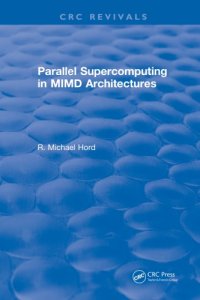
Ebook: Parallel supercomputing in MIMD architectures
Author: Hord R. Michael
- Tags: Parallel processing (Electronic computers), Supercomputers., Computer architecture., COMPUTERS / Computer Literacy., COMPUTERS / Computer Science., COMPUTERS / Data Processing., COMPUTERS / Hardware / General., COMPUTERS / Information Technology., COMPUTERS / Machine Theory., COMPUTERS / Reference.
- Series: CRC revivals
- Year: 2018
- Publisher: CRC Press
- City: Boca Raton, FL
- Language: English
- pdf
Parallel Supercomputing in MIMD Architectures is devoted to supercomputing on a wide variety of Multiple-Instruction-Multiple-Data (MIMD)-class parallel machines. This book describes architectural concepts, commercial and research hardware implementations, major programming concepts, algorithmic methods, representative applications, and benefits and drawbacks. Commercial machines described include Connection Machine Read more...
Abstract: Parallel Supercomputing in MIMD Architectures is devoted to supercomputing on a wide variety of Multiple-Instruction-Multiple-Data (MIMD)-class parallel machines. This book describes architectural concepts, commercial and research hardware implementations, major programming concepts, algorithmic methods, representative applications, and benefits and drawbacks. Commercial machines described include Connection Machine 5, NCUBE, Butterfly, Meiko, Intel iPSC, iPSC/2 and iWarp, DSP3, Multimax, Sequent, and Teradata. Research machines covered include the J-Machine, PAX, Concert, and ASP. Operating systems, languages, translating sequential programs to parallel, and semiautomatic parallelizing are aspects of MIMD software addressed in Parallel Supercomputing in MIMD Architectures. MIMD issues such as scalability, partitioning, processor utilization, and heterogenous networks are discussed as well.This book is packed with important information and richly illustrated with diagrams and tables, Parallel Supercomputing in MIMD Architectures is an essential reference for computer professionals, program managers, applications system designers, scientists, engineers, and students in the computer sciences